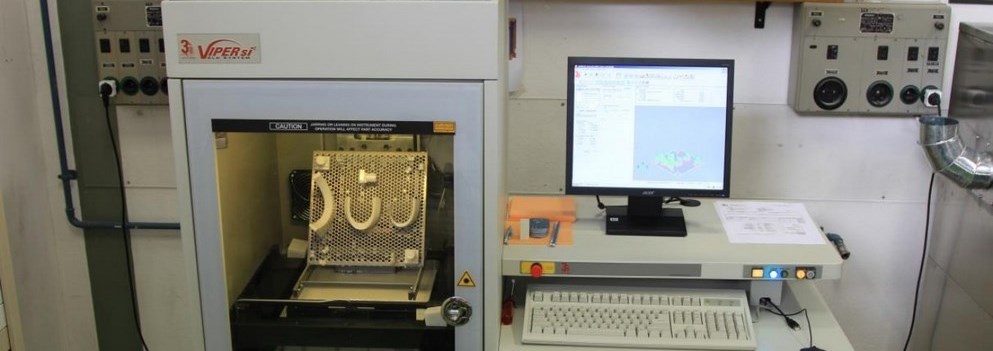3D printing in high energy physics

In order not to start each post with a dry narration about purely scientific facts and speculation, I suggest you smoothly plunge into the atmosphere of harsh physicists through one of the most popular high-tech themes of recent years (no, this is not about seals).
Today I will tell you about 3D printing in relation to the solution of several problems, one way or another connected with high energy physics.
About a month ago, the daily journal Fermilab Today of the Enrico Fermi National Accelerator Laboratory published a note about the difficult everyday life of engineers and scientists of this laboratory, and 3D printing as a means of all problems.
So, back in 2008, the junior research associate at the Fermi Laboratory, Mauricio Lopes, began creating a model of some kind of cardboard spiral solenoid to substantiate the feasibility of the concept of the model being developed. This process (quite expectedly) went very slowly, Lopez’s patience snapped, and he attended to acquiring an installation for 3D printing. In October 2009, the laboratory received a long-awaited 3D printer for printing plastic models. And, as they say, it started - they began to print both plastic prototypes (for example, photographs of prototypes of stannid superconducting cables - Nb3Sn alloy), and metal parts ( photo of cores for superconducting magnets winding: on the left — obtained using 3D printing, on the right — made in the traditional way).
')
A week ago, an interesting seminar was held at CERN, at which a report on the topic “A new installation for 3D printing in the laboratory of polymeric materials. Possibilities and limits of its application. " View the slides here .
Currently, the following three-dimensional printing technologies are applied at CERN:
- Fused Deposition Modeling . The three-dimensional model is formed by the method of layer-by-layer formation of a fusible filament, which then solidifies. The most common technology of three-dimensional printing, used in almost all 3D printers in the lower price range.
- Laser stereolithography, or Laser Stereolithography . The method of obtaining three-dimensional models from a special liquid - photopolymerizable composition. As it is easy to guess from the name, the hardening of the photopolymer occurs under the influence of laser radiation.
- Selective Laser Sintering, or Selective Laser Sintering . The process of obtaining the product is similar to the previous one, with the only difference that the working material in this case is powder (metal or plastic). The formation of the model also occurs in layers, by a series of consecutive laser irradiations.
The same report presents a photograph of the model and a photograph of the final part obtained by laser stereolithography.
It is clear that the products manufactured by these methods always have certain disadvantages in relation to the parts obtained by traditional processing (lower strength and rigidity of the material of the products, lower manufacturing accuracy, low resistance to aggressive environmental conditions, etc.). Despite these shortcomings, parts “printed out” on local 3D printers are successfully used in such unexpected areas as low-temperature and vacuum equipment, high-voltage electrical equipment, and even scintillator lenses.
Also at CERN itself, the following properties of "printed" products from various materials were studied:
- mechanical strength at normal temperatures
- mechanical strength at low (~ 77 K) temperatures
- thermal shrinkage
- resistance to high voltage electrical effects
- resistance to mechanical vibration
- and even changes in mechanical properties due to radiation exposure .
Finally, let's take a look at what 3D printers print on the Big Hadron Collider itself:
- plastic shell RF antenna
- high-voltage connectors for the amplifier of the transverse beam stabilization system
- details of windings of superconducting solenoids .
In other scientific institutions of the world, things are similar: 3D printing is actively used for prototyping, the proportion of metallic “printing” is growing, the expansion of 3D printing is welcomed, for which efforts of laboratories themselves and studies of the applicability of printed products in various areas are conducted. Modern 3D printing is not just gadgets for geeks that can print an exclusive iPhone case or a beautiful case for the Raspberry Pi, but quite a serious and useful tool for prototyping and individual production of the most diverse and, importantly, responsible products. Ask physicists, they will confirm.
Sources:
http://www.fnal.gov/pub/today/archive/archive_2013/today13-08-21.html
http://indico.cern.ch/getFile.py/access?resId=1&materialId=slides&confId=271447
http://thescience.ru/2013/09/20/3d-printing-in-high-energy-physics/
Source: https://habr.com/ru/post/194446/
All Articles